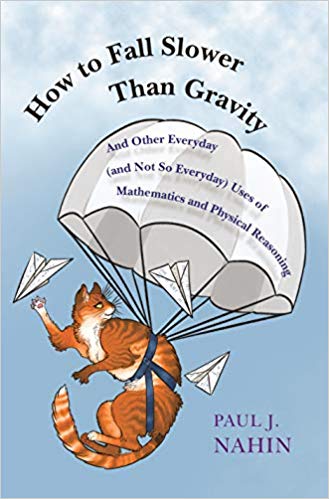
The cover text says How to Fall… is “more than a puzzle book”, which is roughly how I was planning to describe it: twenty-six questions that require an element of mathematical or physical thought, followed by solutions in the obvious bijection.
Puzzle books, for me, are hit and miss – I’ve had a steady diet of pop-maths puzzles for the last three decades, and I’m cynical and jaded enough to expect a book of such things to be of little interest: either I’ve seen most of them before, or I’m just not interested in the topics at hand. Nahin’s book is something like an enthusiastic rookie that shakes me out of my cynicism.
The puzzles generally have a mechanics flavour (as you might expect from the title), starting with catapults and snow-ploughs – but there’s some pure scattered about as well – linking \( \int_0^1 x \lfloor \frac{1}{x} \rfloor \mathrm{d}x \) with the Basel problem, or (more familiarly) comparing \( e^\pi \) with \( \pi^e \). There’s a section on Monte Carlo methods, on combinatorics, on a puzzling popular physics problem of how long it takes for a particle to slide off of a sphere, on cubics and quartics, on congruences, on the zeta function. It covers a wide range of topics in enough depth for the casual reader to decide whether they’re interesting enough to explore further.
It claims to require only high-school maths to understand, which I think is a bit of a stretch – although I’d expect a good A-level student to enjoy it and a Further Maths student to be there and thereabouts with it. It’s much more equation-heavy than, I think, any pop-maths book I’ve ever seen (for me, and presumably you, dear Aperiodical readers, that’s a plus, although a more general audience might disagree). And I’m a bit perturbed by the typesetting of the MATLAB code in a – prepare the smelling salts – non-monospace font. I’d also have liked a link to a repository of the code – a cursory search doesn’t turn any such thing up.
For all that, Nahin has a knack for clear and light exposition, dropping in barbs and sardonic adverbs when it makes sense to, more good-natured than comical, interspersing historical anecdotes. I think this book is of interest to any mathematician with a passing interest in mechanics – the problems are unusual and challenging, and the explanations engaging. I recommend it!
* Colin received a review copy of this book.